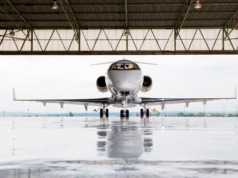Are you considering purchasing your first business aircraft?
Save time and money by using processes successfully followed by others and applying them to your unique requirements. Be aware that your optimal structure may be different than your colleague’s or friend’s because there is no “one-size-fits-all” aircraft ownership structure.
As you begin the process, use these five steps to guide you.
ONE: Pick Your Acquisition Team and Let Them Talk
No one person is an expert on aircraft maintenance, aircraft valuation, tax issues, financing, and FAA regulations. You’ll need to assemble a team of subject matter experts who know industry best practices for acquiring and operating an aircraft. Your team likely will include: an aircraft sales representative or broker, aviation tax advisor, aviation attorney, pilot, insurance broker, and financier, who will work together with you to identify your needs and requirements, and any specific issues you may face.
They will help you create a plan based on a reasonable estimate of what is likely to happen, not on an ideal set of expectations with a low probability of occurring. And they will help you avoid unintended consequences. For example, if you plan for all business use of the jet, but then decide to use it for several personal trips in December, the month in which you buy it, there may be unpleasant tax implications.
Your team will bring you their best suggestions, so you can make wise and informed decisions on the acquisition and operation of your new aircraft.
TWO: Identify Your Needs and Goals
Consider these questions:
- Why are you buying an aircraft (security, privacy, health, increased travel)?
- What is your budget?
- What is your flight range (most flights are of two to three hours, or fifteen hours)?
- What is the number of passengers on a typical flight?
- How much luggage or equipment will you carry?
- Will you be financing the purchase of the aircraft?
- Do you want to lease or charter the aircraft to others for some supplemental revenue when you are not using it?
- Do you plan to set up your own flight department or hire an aircraft management company?
Clarifying these answers at the outset is critical to achieving your primary goals. This initial input by you and your team will result in the purchase of an aircraft that fits your needs, is eligible for applicable tax deductions, and is operated in compliance with all IRS and FAA regulations.
THREE: Understand the Purchase Price and Operating Costs
After answering these questions, and with advice from your team, you will have a good idea of the amount you’ll be spending on the purchase of the make and model of aircraft that best meets your needs. You’ll also need to calculate annual fixed and variable costs: insurance, fuel, pilots, maintenance, a hangar or parking spot, and many other items. Your acquisition team or the aircraft management companies you’ll be interviewing can provide an initial estimated budget.
FOUR: Plan Early for Financing
Obtaining quotes on financing, selecting a lender, providing due diligence, and reviewing loan documents takes weeks, not days. Aircraft purchase agreements do not include a financing contingency clause, so allow plenty of time to have your financing ready for closing. Another option is to pay cash at closing and complete the financing after closing.
FIVE: Assign Business Personnel to Make Some Decisions
To minimize your involvement in the tax and legal details, assign trusted business personnel to handle some of these decisions. This frees you up to work on your core business.
First time aircraft buyers are confronted with a surprising number of moving parts and decision points. Start early and work with experienced professionals to ensure a pleasant purchase experience and enjoy operating your first aircraft. BAA
Michelle Wade is an aviation attorney at Jetstream Aviation Law, P.A. and counsels clients on the acquisition, financing and operation of corporate jets operated under Part 91 and Part 135 of the Federal Aviation Regulations.





